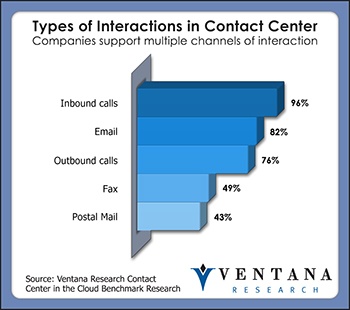In never ceases to amaze me, the number of new terms and acronyms the contact center market generates. Just as everyone is getting used to the fact that customers interact with companies through multiple communication channels (multichannel for short), someone invents the term omnichannel and we all have to get our heads around what this means. My research into the contact center in the cloud shows that companies now support on average nearly five communication channels, and although the traditional channels are still the most common, as the chart shows, there are signs that new channels such as chat (used by 37%), social media (29%), text messaging (22%) and video (5%) are on the increase.
the contact center market generates. Just as everyone is getting used to the fact that customers interact with companies through multiple communication channels (multichannel for short), someone invents the term omnichannel and we all have to get our heads around what this means. My research into the contact center in the cloud shows that companies now support on average nearly five communication channels, and although the traditional channels are still the most common, as the chart shows, there are signs that new channels such as chat (used by 37%), social media (29%), text messaging (22%) and video (5%) are on the increase.
The term omnichannel connotes “all in one,” and in this context it implies that companies need to integrate all these channels to give customers the same experience regardless of the channel they use. But I can think of three reasons why this is almost impossible today. The first is that each of these channels uses different devices, and try as companies might, they can’t achieve the same experience on a small mobile device, a laptop, in a text message, in 140 characters, face-to-face, or during a video call. Second, many companies still operate legacy communication systems, especially on-premises, proprietary ACDs, and integrating these with new channels is too costly in today’s economic climate. Emerging contact-center-in-the-cloud vendors such as Echopass, Enghouse Interactive, Five9, Interactive Intelligence, LiveOps and NewVoiceMedia offer a solution as their services typically include integrated multiple channels of communication. Even so, companies are often faced with deciding how to integrate these with their existing systems. Third, my research also shows that interactions are increasing handled by people in the lines of business, which are spread across the organization and typically have their own processes, systems and customers; therefore customers are likely to get different information depending on the line of business they interact with.
Another important factor is that many companies don’t truly know their customers. My research into customer relationship maturity shows that fewer than one in three (31%) companies produce a single report and analysis of their customers that is shared across the organization. This means that the lines of business are acting on different information, another reason why it is almost impossible to provide a single, consistent experience at all touch points. As companies add more channels of communication this challenge becomes greater, especially when they need to integrate more and more unstructured data into their customer analysis – the big data effect. Adding more channels of communication introduces yet another challenge. Typically each channel uses a unique identifier, and business applications have additional keys; these include, for example, a phone number, an email address, a Twitter handle, an account number or an order number. To truly know a customer companies therefore must link all these identifiers so they can, for example, identify that a current caller is the same person who posted a tweet and sent an email.
To deal with these challenges, I recommend that companies take the following steps:
- Improve the quality and consistency of their customer data so they have one up-to-date master customer record.
- Apply customer analytics to every possible source of customer data, including transaction, interaction and event data, structured and unstructured data, and historic, real-time and predictive analysis.
- Use this analysis first at every touch point to know the customer.
- Use this analysis also to put the current interaction into the context of previous interactions and the overall relationship with the customer.
- Use this analysis in combination with rules-based logic to make the response personal to the customer and relevant to the issue raised, and therefore likely to result in the desired business outcome.
- Above all else, companies need to ensure that they provide consistent information across channels and lines of business. Otherwise they face the prospect that customers will channel-hop until they get the information or outcome that suits them best. Such a process is likely to cost companies customers and sales.
I am not sure such an approach will produce an omnichannel customer experience, but it provides a practical, achievable process that is likely to improve the customer experience and outcomes. I would welcome comments on how others view the concept of omnichannel customer experience and how they intend to achieve it, so please come and collaborate with me.
Regards,
Richard J. Snow
VP & Research Director










